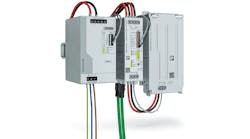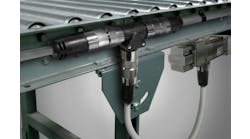What happens to a control system and related automation when voltage spikes or sags occur or when control power is unexpectedly lost, even for a short period of time? The result may vary from small to catastrophic failure, and restarting the system can be time-consuming. Keeping equipment running requires understanding a few of the many problems that may occur, the needs of the specific application and then identifying solutions to ride out power disruptions.
The laptop being used during the workday can continue operating locally during a power outage. However, network routers often stop working until power is restored. While the battery in the laptop may ensure no work is lost, that is not always the case. It depends on the application. The same is true for control systems, and the design should consider the system response to power changes and keep possible data loss to a minimum.
Supplying clean power to a control system, free of spikes, surges and sags is important, as even a quick loss of power, such as when the lights flash off and on, can shut down a control system. Not only can it cause a machine to drop out of cycle or trigger an emergency stop, but the PLC can also lose its program memory and/or non-retentive variable data. After a power surge hits the controller, it may even be necessary to reload the PLC program at the compact flash module level. It happens.
A brief disruption or loss of power can also cause data loss. Some controllers draw a very clear line between retentive and non-retentive data. The non-retentive is lost when power turns off, and even if programming is added to save the data to a file, that function likely will not work when power is unexpectantly removed, even for short durations.
A long-used and still relevant industrial control system standard from the automotive industry requires that the PLC, HMI and PC be on a separate circuit and remain powered even if the main disconnect is turned off. This circuit is fed from the line side of the main disconnect and includes branch circuit protection, disconnect and step-down transformer. This circuit remains powered when the main disconnect is turned off, and orange or yellow wires and a warning sign, as part of the installation, should signify that some circuits remain powered.
[javascriptSnippet ]
[pullquote]The step-down transformer does provide minimal protection against high-frequency voltage spikes, but it does not do much for voltage surges or sags. Voltage regulation is often needed. A better solution is a constant voltage transformer (power conditioner), which some automotive plants require. This creates a well-regulated sinusoidal waveform that is isolated from electrical disturbances such as spikes, surges, sags, brownouts and waveform distortion.
These power control and condition methods are current good manufacturing practices, but what happens to the controllers and data when the power supply is interrupted? The results do vary, but if the application requires that power be maintained, an uninterruptable power supply (UPS) must be used. When power is lost or if it fluctuates outside specific, safe levels, a UPS instantly provides surge-free, clean battery backup power for equipment such as controllers, HMIs and PCs.
Some applications such as industrial control systems, computer servers, traffic signals, security systems, office computers and mission critical systems benefit from the use of a UPS, but how much of the control system is connected to the UPS and the actual power draw of the equipment must be determined. The UPS must also be monitored and be maintained.
Controllers and computers are likely candidates for UPS power, as are network switches and routers, smart edge devices and instrumentation. While UPS is capable of supplying thousands of kilowatts of power, the plan rarely involves keeping an entire automated machine running during a loss of power. The automation will stop, but the controllers and computers systems may benefit from having the time to complete an orderly shutdown.
To shutdown properly, the control system must monitor the UPS. This is typically done through discrete contacts on the UPS. When the control system or computer detects that it is running on backup power, it can be programmed to complete an orderly shutdown and save the appropriate data files to maintain data integrity.
How long the system can run under backup power is a critical decision. Sometimes minutes is enough, but hours may be desirable depending on the system’s needs. With the battery-backed-up components and the backup runtime determined, the actual load requirement must be calculated. Fortunately, many UPS manufacturers provide software or worksheets to simplify the calculations. A key part of these calculations is to use actual running current, not the nameplate current, which is often two to three times higher than actual current draw.
There are many reasons to use a UPS, and many features enabled by the Internet of Things allow remote monitoring and maintenance. With the advancements in UPS systems, it has never been easier to keep clean power flowing to a control system.






